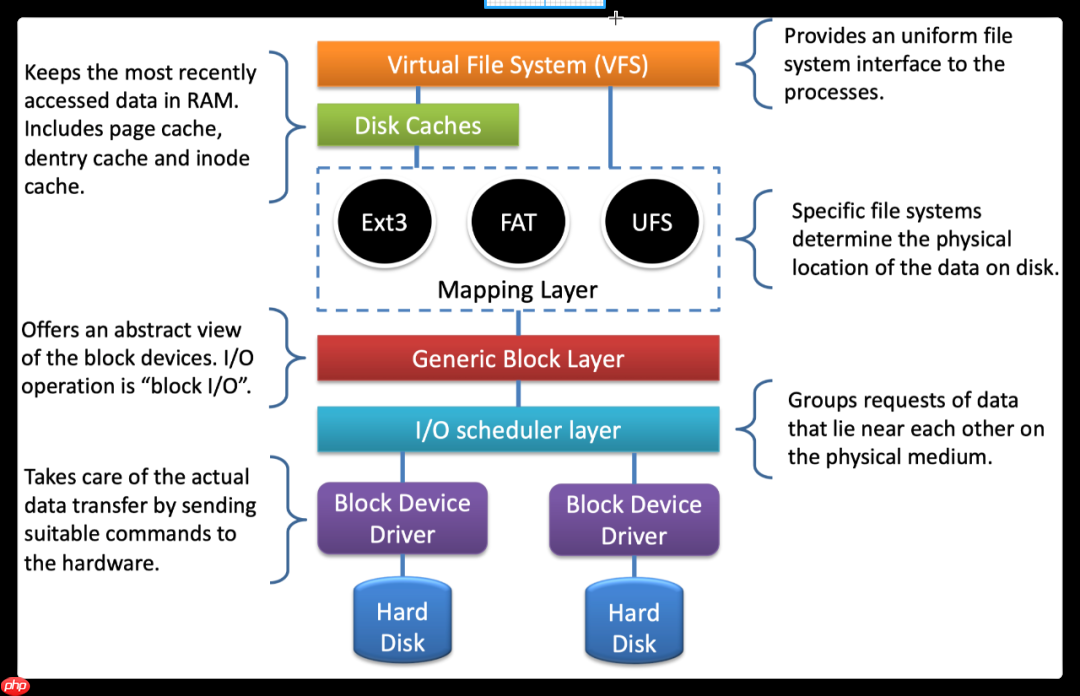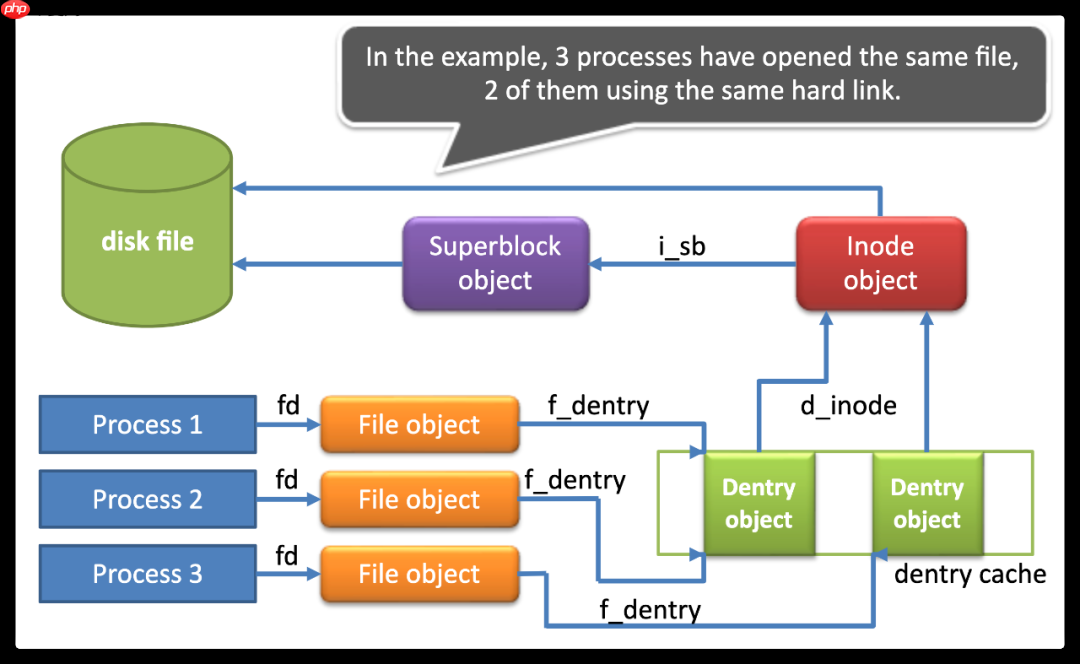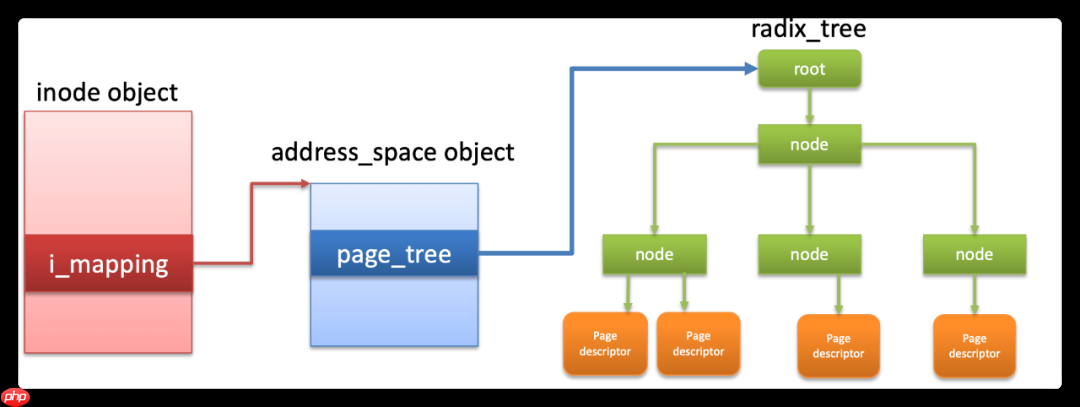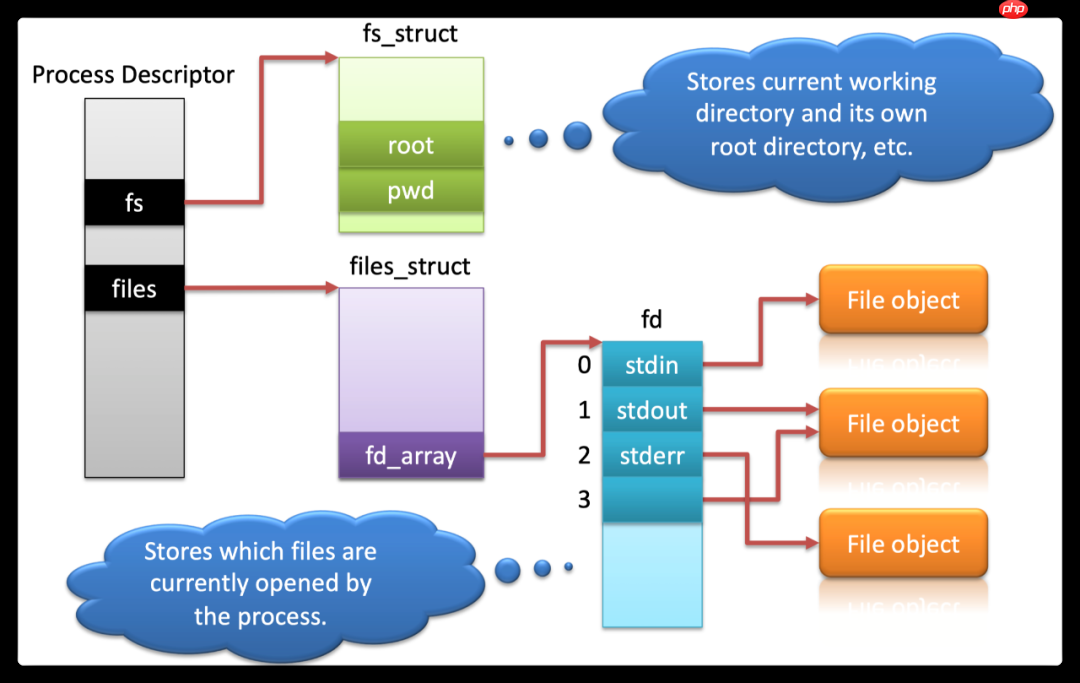在宏观层面上,文件系统在内核中的运作流程可以概括为从虚拟文件系统(vfs)到实际磁盘文件系统的一系列步骤:vfs -> 磁盘缓存 -> 实际磁盘文件系统 -> 通用块设备层 -> io调度层 -> 块设备驱动层 -> 磁盘。具体的操作流程如图所示:

理解文件系统中的数据结构是理解Linux文件系统运作的关键。Linux中的文件系统包含几种核心数据结构:super_block、inode、dentry和file。
super_block:这是磁盘文件系统(如XFS、EXT4)的内存表示。它包含了文件系统的基本信息和操作函数表,确保不同文件系统能够通过通用接口与VFS交互。
inode:在Linux中,每个文件都有一个唯一的inode,它存储了文件的元数据,如文件大小、权限、时间戳等。inode还包含了指向文件内容的指针。
dentry:dentry代表文件系统中的目录项,存储了文件名和指向其inode的指针。dentry帮助构建文件系统的目录结构。
file:当文件被打开时,会为该文件创建一个file结构体实例,记录文件的当前状态,如打开标志和文件位置等。每个进程对文件的系统调用都会产生一个file实例。
这些数据结构通过函数表和私有数据实现了工厂设计模式,使得不同文件系统能够注册自己的实现方法,确保VFS能够与各种实际磁盘文件系统交互。

以下是各核心数据结构的简要代码描述:
// struct super_block 省略了一些字段,描述了核心字段
struct super_block {
// 将super_block链接到s_list链表
struct list_head s_list;
// s_blocksize的位数
unsigned char s_blocksize_bits;
// 文件系统中块大小
unsigned long s_blocksize;
// 支持最大文件大小
loff_t s_maxbytes;
// 文件系统类型
struct file_system_type *s_type;
// super_block的操作函数
const struct super_operations *s_op;
// dentry函数操作定义
const struct dentry_operations *s_d_op;
// dentry的指针,指向根节点的root
struct dentry *s_root;
// 挂载该文件系统的挂载点组成的链表
struct list_head s_mounts;
// 同一种文件系统组成的链表
struct hlist_node s_instances;
// 实际文件系统的私有数据
void *s_fs_info;
} __randomize_layout;// 每个文件系统在初始化时都会先注册这个文件系统,file_system_type就是用来描述这个文件系统的
struct file_system_type {
// 文件系统名称,比如ext4、xfs
const char *name;
// 实际文件提供的mount函数用来初始化super_block
struct dentry *(*mount) (struct file_system_type *, int, const char *, void *);
// 释放文件系统的函数
void (*kill_sb) (struct super_block *);
// 内核模块描述
struct module *owner;
// file_system_type链表
struct file_system_type *next;
// 同一种文件系统super_block组成的链表
struct hlist_head fs_supers;
};
// 比如ext4的file_system_type的类型
static struct file_system_type ext4_fs_type = {
.owner = THIS_MODULE,
.name = "ext4",
.mount = ext4_mount,
.kill_sb = kill_block_super,
.fs_flags = FS_REQUIRES_DEV,
};// 文件系统中inode描述,其中说明了核心字段的函数
struct inode {
// 文件类型
umode_t i_mode;
// uid/gid是描述文件的属主
kuid_t i_uid;
kgid_t i_gid;
// inode的操作函数,这个是由具体文件系统决定
const struct inode_operations *i_op;
// inode属于的超级块
struct super_block *i_sb;
// page cache涉及到缓存管理
struct address_space *i_mapping;
// inode的编号,单个文件系统内这个是唯一的
unsigned long i_ino;
// inode所指向的文件大小
loff_t i_size;
// 文件的acess/mofidy/change时间
struct timespec64 i_atime;
struct timespec64 i_mtime;
struct timespec64 i_ctime;
// inode链接到哈希链表中
struct hlist_node i_hash;
// inode链接到super_block上
struct list_head i_sb_list;
union {
// 进程打开文件时候的操作函数,这个是与文件类的系统调用对接
const struct file_operations *i_fop;
void (*free_inode)(struct inode *);
};
// inode的私有数据,一般存储实际文件系统的私有数据
void *i_private; /* fs or device private pointer */
} __randomize_layout;inode中的i_mapping用于缓存,其具体的关系如下:

// 文件系统的目录树是采用组织dentry来呈现
struct dentry {
// 指向父目录的dentry
struct dentry *d_parent;
// 保存了文件名字和哈希值
struct qstr d_name;
// 该目录项指向的inode
struct inode *d_inode;
// 当目录项名称比较短的时候保存在这里
unsigned char d_iname[DNAME_INLINE_LEN]; /* small names */
// 定义dentry的操作函数,每个文件系统都针对d_op进行初始化
const struct dentry_operations *d_op;
// dentry私有数据
void *d_fsdata; /* fs-specific data */
union {
struct list_head d_lru; /* LRU list */
wait_queue_head_t *d_wait; /* in-lookup ones only */
};
// 当前dentry所有父目录项的链表
struct list_head d_child; /* child of parent list */
// 当前目录项下所有子目录项的链表
struct list_head d_subdirs; /* our children */
} __randomize_layout;// 每当进程打开一个文件都会实例化一个struct file,这里面包含了标准的posix语义的操作
struct file {
// 文件路径
struct path f_path;
// 文件指向的inode
struct inode *f_inode;
// 定义struct file的操作函数
const struct file_operations *f_op;
// 文件的引用计数器
atomic_long_t f_count;
// 文件打开的flags
unsigned int f_flags;
// 文件的mode
fmode_t f_mode;
// 文件的当前位置
loff_t f_pos;
// struct file的私有数据
void *private_data;
// 文件的page cache相关的address_space
struct address_space *f_mapping;
} __randomize_layout;进程打开一个文件的呈现如下面所示:

以上就是浅谈文件系统中的核心数据结构的详细内容,更多请关注php中文网其它相关文章!

每个人都需要一台速度更快、更稳定的 PC。随着时间的推移,垃圾文件、旧注册表数据和不必要的后台进程会占用资源并降低性能。幸运的是,许多工具可以让 Windows 保持平稳运行。

Copyright 2014-2025 https://www.php.cn/ All Rights Reserved | php.cn | 湘ICP备2023035733号